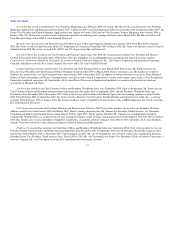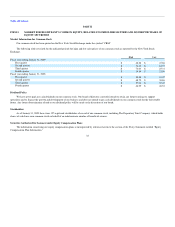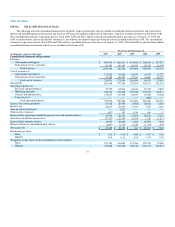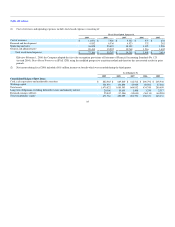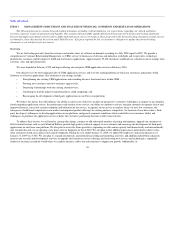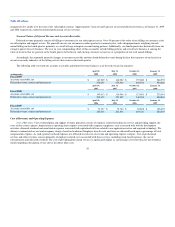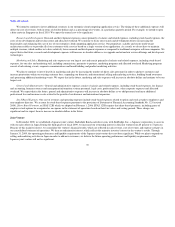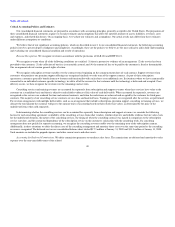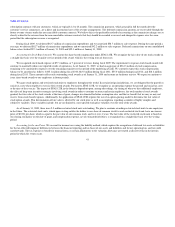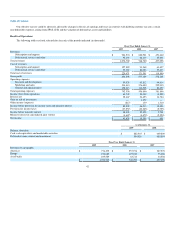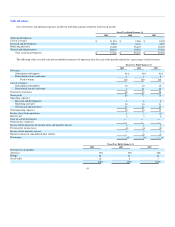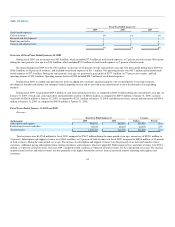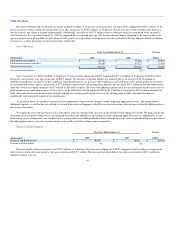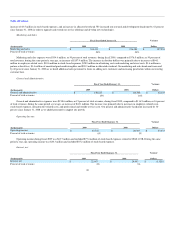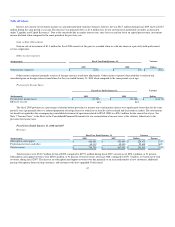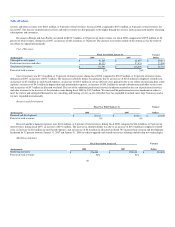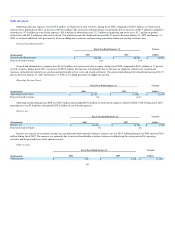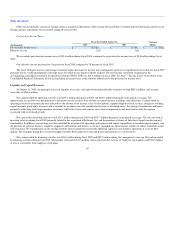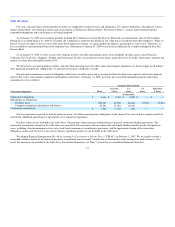Salesforce.com 2008 Annual Report Download - page 44
Download and view the complete annual report
Please find page 44 of the 2008 Salesforce.com annual report below. You can navigate through the pages in the report by either clicking on the pages listed below, or by using the keyword search tool below to find specific information within the annual report.
Table of Contents
subscription contracts with our customers, which are typically 12 to 24 months. The commission payments, which are paid in full the month after the
customer's service commences, are a direct and incremental cost of the revenue arrangements. The deferred commission amounts are recoverable through the
future revenue streams under the non-cancelable customer contracts. We believe this is the preferable method of accounting as the commission charges are so
closely related to the revenue from the non-cancelable customer contracts that they should be recorded as an asset and charged to expense over the same
period that the subscription revenue is recognized.
During fiscal 2009, we deferred $63.7 million of commission expenditures and we amortized $58.7 million to sales expense. During the same period a
year ago, we deferred $62.7 million of commission expenditures and we amortized $42.2 million to sales expense. Deferred commissions on our consolidated
balance sheet totaled $57.1 million at January 31, 2009 and $52.1 million at January 31, 2008.
Accounting for Stock-Based Awards. We account for share-based compensation under SFAS 123R. We recognize the fair value of our stock awards on
a straight-line basis over the requisite service period of the award, which is the vesting term of four years.
We recognized stock-based expense of $77.4 million, or 7 percent of revenue, during fiscal 2009. The requirement to expense stock-based awards will
continue to materially reduce our reported results of operations. As of January 31, 2009, we had an aggregate of $261.3 million of stock compensation
remaining to be amortized to expense over the remaining requisite service period of the underlying awards. We currently expect this stock compensation
balance to be amortized as follows: $105.1 million during fiscal 2010; $83.0 million during fiscal 2011; $55.0 million during fiscal 2012; and $18.2 million
during fiscal 2013. These amounts reflect only outstanding stock awards as of January 31, 2009 and assume no forfeiture activity. We expect to continue to
issue share-based awards to our employees in future periods.
We grant stock options and restricted stock units to employees throughout the world. In certain foreign jurisdictions, we are obligated for the payroll or
social tax costs when employees exercise their vested awards. Pursuant to SFAS 123R, we recognize as an operating expense the payroll and social tax costs
at the time of the exercise. The impact of SFAS 123R in the future is dependent upon, among other things, the timing of when we hire additional employees,
the effect of long-term incentive strategies involving stock awards in order to continue to attract and retain employees, the total number of stock awards
granted, the fair value of the stock awards at the time of grant, changes in estimated forfeiture assumption rates and the tax benefit that we may or may not
receive from stock-based expenses. Additionally, the application of SFAS 123R requires the use of an option-pricing model to determine the fair value of
stock option awards. This determination of fair value is affected by our stock price as well as assumptions regarding a number of highly complex and
subjective variables. These variables include, but are not limited to, our expected stock price volatility over the term of the awards.
As of January 31, 2009, there were 2.5 million restricted stock units outstanding. We plan to continue awarding restricted stock units to our employees
in the future. The restricted stock units, which upon vesting entitles the holder to one share of common stock for each restricted stock unit, have an exercise
price of $0.001 per share, which is equal to the par value of our common stock, and vest over 4 years. The fair value of the restricted stock units is based on
our closing stock price on the date of grant, and compensation expense, net of estimated forfeitures, is recognized on a straight-line basis over the vesting
period.
Accounting for Income Taxes. We account for income taxes using the liability method, which requires the recognition of deferred tax assets or liabilities
for the tax-effected temporary differences between the financial reporting and tax bases of our assets and liabilities and for net operating loss and tax credit
carryforwards. The tax expense or benefit for unusual items, or certain adjustments to the valuation allowance are treated as discrete items in the interim
period in which the events occur.
41


